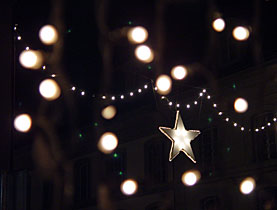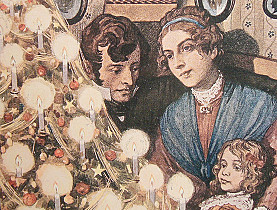Christmas lights spark electricity concerns

As the number of lights increases in Switzerland every Christmas, questions are being asked about whether they are a waste of precious electricity.
There are concerns about the climate and a shortage of electricity in Switzerland after the year 2020.
Many towns and villages used to decorate a local tree with lights at Christmas, but nowadays street decorations and illuminated shop windows shine alongside the rising number of electric window displays put up in private homes.
Giuseppina Togni from the Swiss Agency for Efficient Energy Use said Christmas lighting accounts for 0.17 per cent of total electricity consumption in Switzerland.
In terms of cost, the agency estimates that private households spend SFr5.4 million ($4.77 million) on festive illuminations. The bill paid by shopkeepers comes to about the same.
Swiss municipalities pay about SFr3.6 million, so total spending in Switzerland comes to SFr14.4 million.
Dorothea Tiefenauer from the Swiss Electricity Company Association emphasises that the general increase in electricity consumption in December makes it difficult to put a figure on the power used by Christmas decorations.
She gives a cautious estimate of 0.01 per cent of total consumption.
Political issue
Erica Hennequin, a politician in canton Jura and former vice-president of the Green Party, recently brought up the issue at cantonal level.
And in Lausanne a month before the festive season politician Yves Ferrari questioned putting up the city’s decorations.
Arnaud Zufferey, a member of the Green party and co-president of an association called Dark Sky, whose aim is to prevent light pollution, is also upset that “the festivities begin earlier and earlier and end later and later”.
He argued this was a factor in the “exponential” growth of electricity consumption in Switzerland.
“We know that Christmas illuminations require approximately the production of a small nuclear power plant. It’s clear that we lack a little light in winter, so the desire for them is understandable.”
Tidy sum
But he added: “There are seven-and-a-half million people in Switzerland. If every person has a 15-watt bulb flashing on the balcony, it comes up to a tidy sum.”
Zufferey and Togni make a plea for moderation. That means switching off decorative lights during the night, using a time switch, avoiding one-upmanship by putting up a decoration that’s bigger than your neighbour’s, and buying lights that do not exceed 20-25 watts.
Although the bill in December might not show much of an increase for households, Swiss local authorities are beginning to take a closer look at what they have to pay and are choosing decorations that use less energy.
“The problem is getting bigger with private households but it is improving with the municipalities,” said Zufferey.
In Lausanne, for example, the authorities are banking on LED technology for the gradual renewal of their Christmas decorations.
Traders
However, many festive decorations are put up by traders who don’t always have the means to invest in LED systems.
In Lucerne, shopkeepers cited technical and financial reasons to explain their loyalty to conventional incandescent bulbs.
But the rather white and cold light produced by LED bulbs isn’t to everyone’s taste.
For example, in 2005 the city of Zurich installed LED tubes to light up its main shopping street – Bahnhofstrasse – but it is now taking a step back in favour of a more romantic feel.
This does not necessarily exclude ecology. Giuseppina Togni said LED bulbs with electricity consumption one-fifth to one-quarter less than conventional bulbs “are nowadays developed in such a way as to project a warmer light”.
This is a Christmas present at a time when the Federal Energy Office has announced that it is expecting supply difficulties in Switzerland from 2020.
swissinfo, based on an article in French by Carole Wälti
In 2006, electricity consumption in Switzerland beat all records.
A total of 57.8 billion kilowatt-hours was consumed, compared with 57.3 kWh in 2005.
As for production in Switzerland, hydroelectric plants supply 52.4%, while nuclear plants provide 42.2%.
The Federal Energy Office is expecting energy supply difficulties in Switzerland from 2020.
The Energy Office says the shortage will affect electricity in particular because the first nuclear power plants will then be going off line as a result of old age.
The Swiss government feels that the construction of a new nuclear power plant is inevitable. As a temporary solution, it is recommending the construction of new gas-fired stations.
After incandescent and discharge bulbs, LEDs are expected to be the next revolution in lighting.
LEDs were first discovered in 1907 but their first commercial use only dates from 1967.
LEDs are semiconductor diodes that typically emit a single wavelength of light when charged with electricity. They have several advantages: they are small, robust, use little energy and have a very long life.

In compliance with the JTI standards
More: SWI swissinfo.ch certified by the Journalism Trust Initiative










You can find an overview of ongoing debates with our journalists here . Please join us!
If you want to start a conversation about a topic raised in this article or want to report factual errors, email us at english@swissinfo.ch.